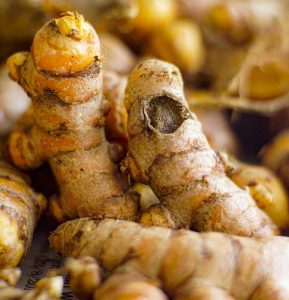Kunyit (Turmeric): A Brief Explanation
"Yellow has long been considered sacred in the East because it symbolizes the sun, the source of light, energy and growth. Thus, it is associated with royalty throughout Asia. In some cases, turmeric is used as a substitute for saffron. It is widely believed that turmeric offers protection against evil spirits, which accounts for its prominence in Hindu culture and at weddings and circumcision ceremonies in Indonesia. Buddhist monks use turmeric to dye their robes (Susan Jane Beers, 2013). "Published by : Farida - 08/04/2021 21:17 WIB
3 Minutes read.
Kunyit or turmeric (Curcuma longa) is often found in various regions in Indonesia. This spice plant has branching rhizomes that clumps together. They originally are from India and can grow as wild or cultured plants. In Indonesia, kunyit is known by various names such as hunik (Batak), temu kuning or kunir (Java), koneng (Sundanese), konyet or temu koneng (Madura), kunidi (North Sulawesi), Kuminu (Ambon), and Rame (Papua). In other countries kunyit is known as yin cin or chiang huang (China), indian saffron or turmeric (English), curcuma or safran des indes (France), kurkuma (Italy), and acafraoda india (Portuguese).

This spice is easy to find in Indonesian traditional markets. It is used as a cooking spice and traditional medicine for various ailments. As a cooking spice, kunyit strengthens the taste and offers natural yellow color. As a medicine, turmeric can overcome health problems and does not have side effects to the body.
In addition, turmeric is also used for beauty and body care. Up until now, royal princesses are still being massaged with a paste mixed with turmeric to give their skin a golden glow. Turmeric is also an ingredient in jamu kinasih, a love potion that is believed to bring a whole new meaning to love-making (Susan Jane Beers, 2013).
Kunyit plant classification
Division : Spermatophyta
Subdivision : Angiospermae
Class : Monocotyledonae
Order : Zingiberales
Family : Zingiberaceae
Genus : Curcuma
Species : Curcuma longa
Kunyit morphology
Physically, a kunyit plant has a height of about 40-100 cm. The stem is a pseudo-stem, composed of leaf midribs, and is rather soft. The leaves are oval and elongated. Turmeric has flowers that emerge from the buds of the pseudo-stems with a length of about 10-15 cm. The flowers are white, the outer skin of the rhizome is brownish, while the flesh of the fruit is reddish orange-yellow.
Contents and properties
Since ancient times, kunyit is believed to have medicinal properties and jamu for various types of diseases. The compounds contained in kunyit, namely curcumin and essential oils, have a role as antioxidants, anti-tumor and anti-colic, reduce fat and cholesterol levels in the blood and liver, antimicrobial, antiseptic, and anti-inflammatory. Kunyit has pharmacological effects, such as invigorating blood circulation and vital energy, eliminating menstrual blockages, facilitating labor, expediting bile excretion (cholagogum), carminative and moisturizing (astringent) (Said, 2007).








